高中英语语法:It的用法(1)
- 格式:docx
- 大小:21.16 KB
- 文档页数:9
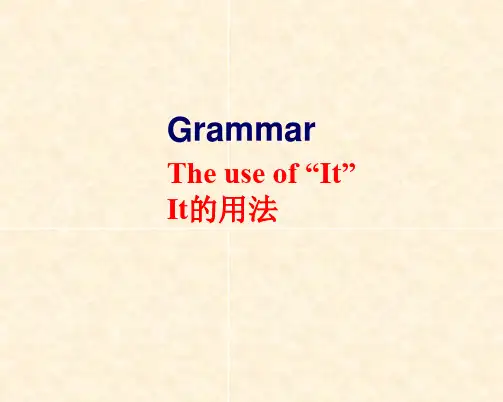
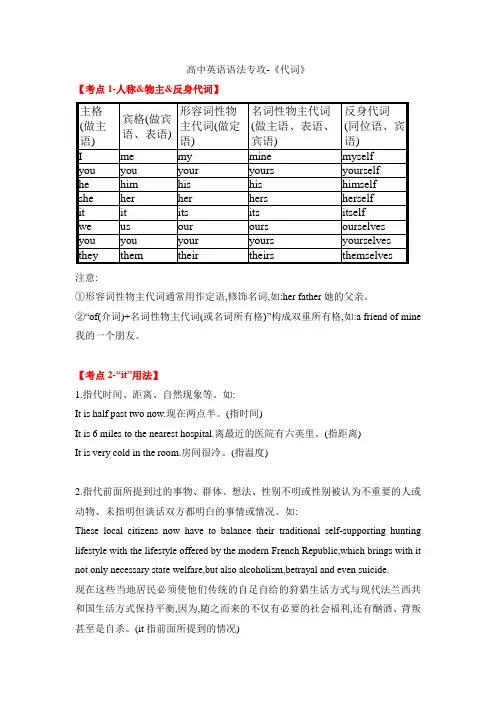
高中英语语法专攻-《代词》【考点1-人称&物主&反身代词】注意:①形容词性物主代词通常用作定语,修饰名词,如:her father她的父亲。
②“of(介词)+名词性物主代词(或名词所有格)”构成双重所有格,如:a friend of mine 我的一个朋友。
【考点2-“it”用法】1.指代时间、距离、自然现象等。
如:It is half past two now.现在两点半。
(指时间)It is 6 miles to the nearest hospital.离最近的医院有六英里。
(指距离)It is very cold in the room.房间很冷。
(指温度)2.指代前面所提到过的事物、群体、想法、性别不明或性别被认为不重要的人或动物、未指明但谈话双方都明白的事情或情况。
如:These local citizens now have to balance their traditional self-supporting hunting lifestyle with the lifestyle offered by the modern French Republic,which brings with it not only necessary state welfare,but also alcoholism,betrayal and even suicide.现在这些当地居民必须使他们传统的自足自给的狩猎生活方式与现代法兰西共和国生活方式保持平衡,因为,随之而来的不仅有必要的社会福利,还有酗酒、背叛甚至是自杀。
(it指前面所提到的情况)—Who’s that at the door?—It is the milkman.——门口那人是谁?——是送奶工。
(it指代性别不明或性别被认为不重要的人)—I’ve broken a plate.我打碎了一个盘子。
—It(=Breaking the plate) doesn’t matter.没关系。
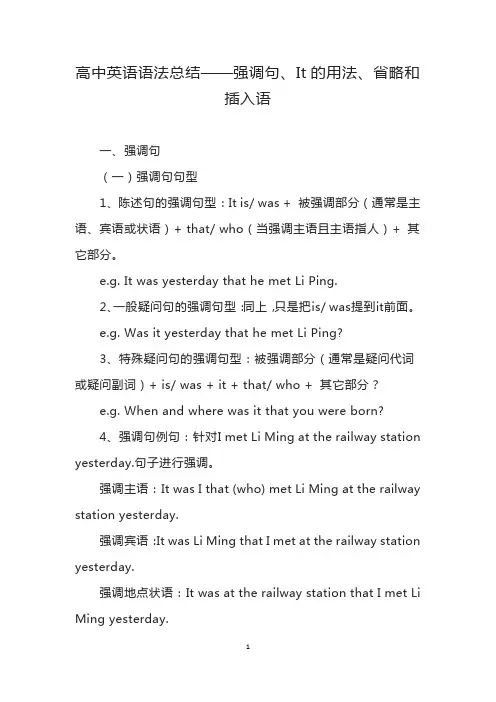
高中英语语法总结——强调句、It的用法、省略和插入语一、强调句(一)强调句句型1、陈述句的强调句型:It is/ was + 被强调部分(通常是主语、宾语或状语)+ that/ who(当强调主语且主语指人)+ 其它部分。
e.g. It was yesterday that he met Li Ping.2、一般疑问句的强调句型:同上,只是把is/ was提到it前面。
e.g. Was it yesterday that he met Li Ping?3、特殊疑问句的强调句型:被强调部分(通常是疑问代词或疑问副词)+ is/ was + it + that/ who + 其它部分?e.g. When and where was it that you were born?4、强调句例句:针对I met Li Ming at the railway station yesterday.句子进行强调。
强调主语:It was I that (who) met Li Ming at the railway station yesterday.强调宾语:It was Li Ming that I met at the railway station yesterday.强调地点状语:It was at the railway station that I met Li Ming yesterday.强调时间状语:It was yesterday that I met Li Ming at the railway station.5、注意:构成强调句的it本身没有词义;强调句中的连接词一般只用that, who,即使在强调时间状语和地点状语时也如此,that, who不可省略;强调句中的时态只用两种,一般现在时和一般过去时。
原句谓语动词是一般过去时、过去完成时和过去进行时,用It was …,其余的时态用It is …。
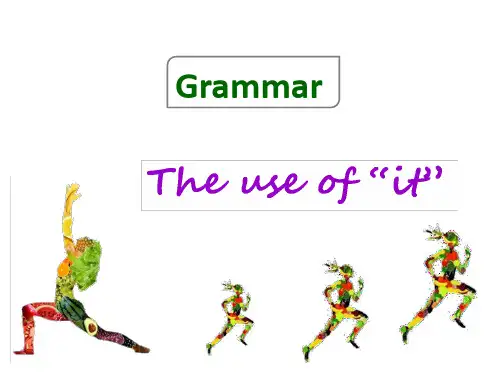
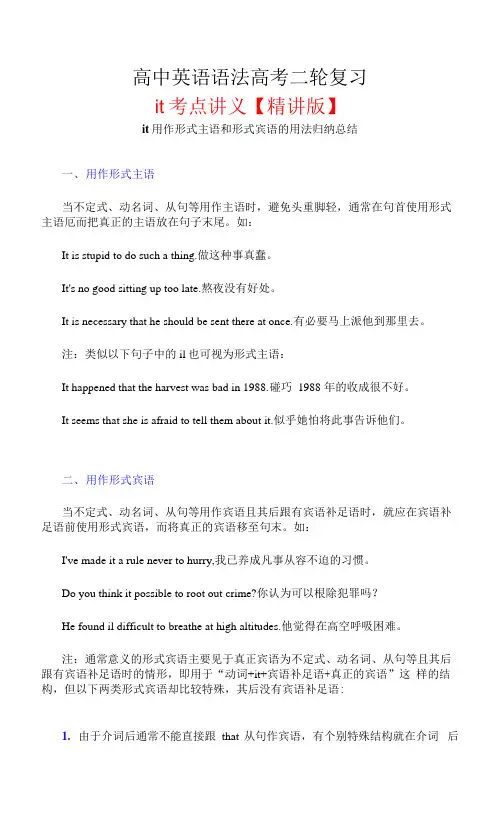
高中英语语法高考二轮复习it考点讲义【精讲版】it用作形式主语和形式宾语的用法归纳总结一、用作形式主语当不定式、动名词、从句等用作主语时,避免头重脚轻,通常在句首使用形式主语厄而把真正的主语放在句子末尾。
如:It is stupid to do such a thing.做这种事真蠢。
It's no good sitting up too late.熬夜没有好处。
It is necessary that he should be sent there at once.有必要马上派他到那里去。
注:类似以下句子中的il也可视为形式主语:It happened that the harvest was bad in 1988.碰巧1988 年的收成很不好。
It seems that she is afraid to tell them about it.似乎她怕将此事告诉他们。
二、用作形式宾语当不定式、动名词、从句等用作宾语且其后跟有宾语补足语时,就应在宾语补足语前使用形式宾语,而将真正的宾语移至句末。
如:I've made it a rule never to hurry,我已养成凡事从容不迫的习惯。
Do you think it possible to root out crime?你认为可以根除犯罪吗?He found il difficult to breathe at high altitudes.他觉得在高空呼吸困难。
注:通常意义的形式宾语主要见于真正宾语为不定式、动名词、从句等且其后跟有宾语补足语时的情形,即用于“动词+it+宾语补足语+真正的宾语”这样的结构,但以下两类形式宾语却比较特殊,其后没有宾语补足语:1.由于介词后通常不能直接跟that从句作宾语,有个别特殊结构就在介词后先接it作形式宾语,再跟that从句。
如:You may depend on it that it is true.你可以相信这是真的。
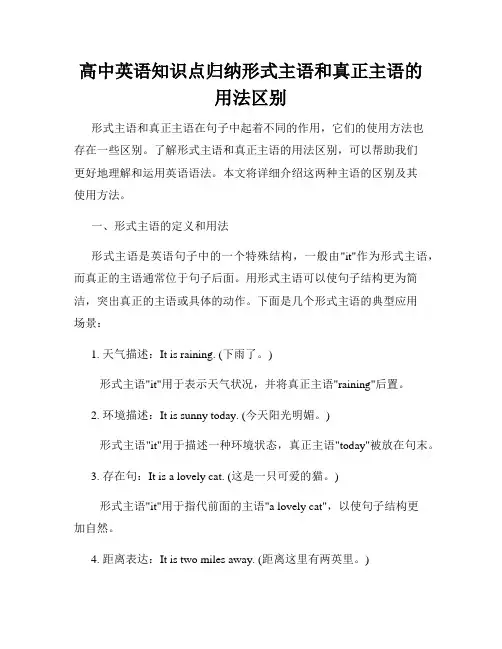
高中英语知识点归纳形式主语和真正主语的用法区别形式主语和真正主语在句子中起着不同的作用,它们的使用方法也存在一些区别。
了解形式主语和真正主语的用法区别,可以帮助我们更好地理解和运用英语语法。
本文将详细介绍这两种主语的区别及其使用方法。
一、形式主语的定义和用法形式主语是英语句子中的一个特殊结构,一般由"it"作为形式主语,而真正的主语通常位于句子后面。
用形式主语可以使句子结构更为简洁,突出真正的主语或具体的动作。
下面是几个形式主语的典型应用场景:1. 天气描述:It is raining. (下雨了。
)形式主语"it"用于表示天气状况,并将真正主语"raining"后置。
2. 环境描述:It is sunny today. (今天阳光明媚。
)形式主语"it"用于描述一种环境状态,真正主语"today"被放在句末。
3. 存在句:It is a lovely cat. (这是一只可爱的猫。
)形式主语"it"用于指代前面的主语"a lovely cat",以使句子结构更加自然。
4. 距离表达:It is two miles away. (距离这里有两英里。
)形式主语"it"用于介词短语中表示距离,真正主语"two miles"位于动词"be"之后。
二、真正主语的定义和用法真正主语指的是句子中进行动作或存在的对象,它在句子中的位置往往较为灵活,可以位于句首、句中或句末。
下面是几个真正主语的常见用法:1. 人称主语:Tom is a student. (汤姆是一个学生。
)真正主语"Tom"作为人的称谓,出现在句首,是一个常见的用法。
2. 名词短语主语:My sister likes to read books. (我的妹妹喜欢读书。
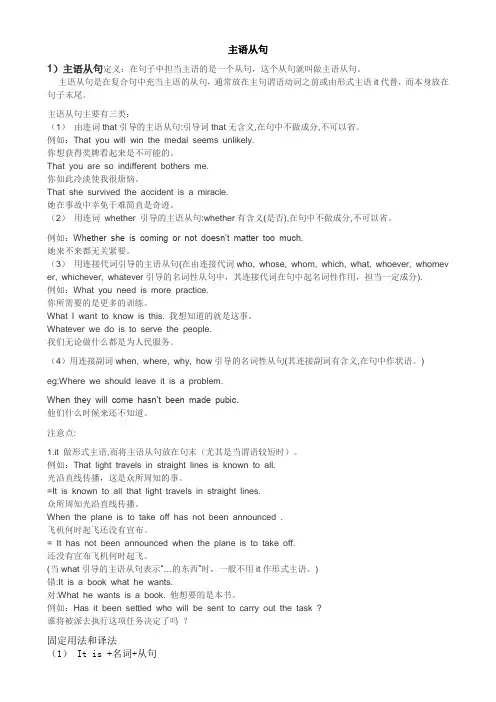
主语从句1)主语从句定义:在句子中担当主语的是一个从句,这个从句就叫做主语从句。
主语从句是在复合句中充当主语的从句,通常放在主句谓语动词之前或由形式主语it代替,而本身放在句子末尾。
主语从句主要有三类:(1)由连词that引导的主语从句:引导词that无含义,在句中不做成分,不可以省。
例如:That you will win the medal seems unlikely.你想获得奖牌看起来是不可能的。
That you are so indifferent bothers me.你如此冷淡使我很烦恼。
That she survived the accident is a miracle.她在事故中幸免于难简直是奇迹。
(2)用连词whether 引导的主语从句:whether有含义(是否),在句中不做成分,不可以省。
例如:Whether she is coming or not doesn’t matter too much.她来不来都无关紧要。
(3)用连接代词引导的主语从句(在由连接代词who, whose, whom, which, what, whoever, whomev er, whichever, whatever引导的名词性从句中,其连接代词在句中起名词性作用,担当一定成分).例如:What you need is more practice.你所需要的是更多的训练。
What I want to know is this. 我想知道的就是这事。
Whatever we do is to serve the people.我们无论做什么都是为人民服务。
(4)用连接副词when, where, why, how引导的名词性从句(其连接副词有含义,在句中作状语。
)eg:Where we should leave it is a problem.When they will come hasn’t been made pubic.他们什么时候来还不知道。
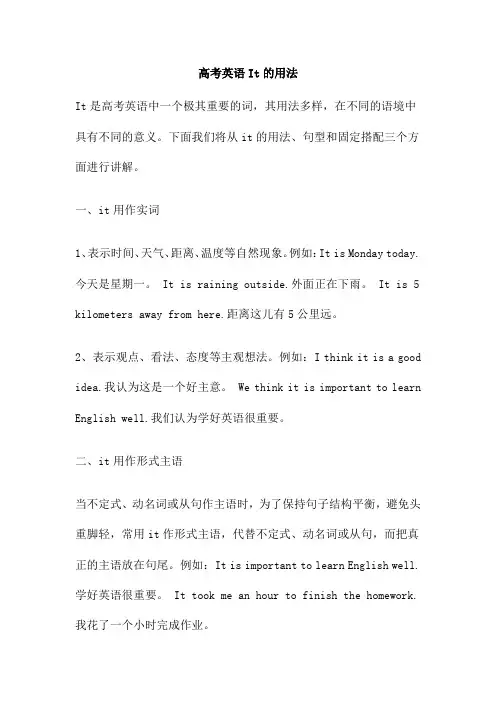
高考英语It的用法It是高考英语中一个极其重要的词,其用法多样,在不同的语境中具有不同的意义。
下面我们将从it的用法、句型和固定搭配三个方面进行讲解。
一、it用作实词1、表示时间、天气、距离、温度等自然现象。
例如:It is Monday today.今天是星期一。
It is raining outside.外面正在下雨。
It is 5 kilometers away from here.距离这儿有5公里远。
2、表示观点、看法、态度等主观想法。
例如:I think it is a good idea.我认为这是一个好主意。
We think it is important to learn English well.我们认为学好英语很重要。
二、it用作形式主语当不定式、动名词或从句作主语时,为了保持句子结构平衡,避免头重脚轻,常用it作形式主语,代替不定式、动名词或从句,而把真正的主语放在句尾。
例如:It is important to learn English well.学好英语很重要。
It took me an hour to finish the homework.我花了一个小时完成作业。
三、it用作形式宾语当不定式、动名词或从句作宾语时,为了保持句子结构平衡,避免头重脚轻,常用it作形式宾语,代替不定式、动名词或从句,而把真正的宾语放在句尾。
例如:I think it is important to learn English well.我认为学好英语很重要。
He found it hard to learn English well.他发现学好英语很难。
四、it用于强调句型中强调句型是英语中一个重要的句型,用于突出强调某个成分,特别是主语、宾语和状语等。
在强调句型中,it没有实际意义,只是起到引导作用。
例如:It is I who am the best student in my class.我是班里最好的学生。
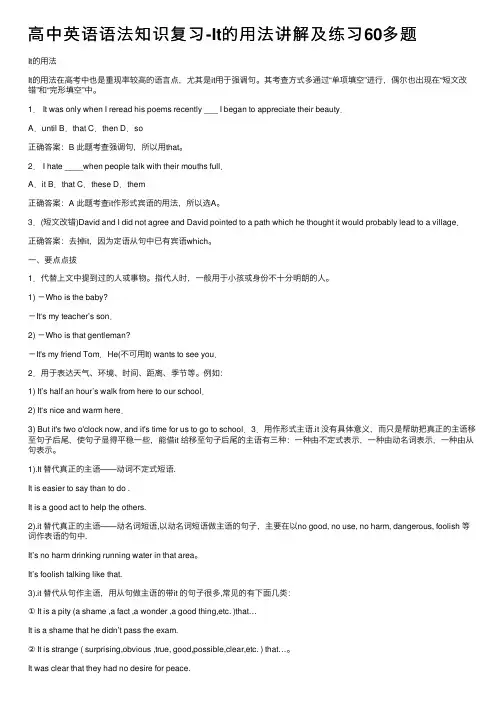
⾼中英语语法知识复习-It的⽤法讲解及练习60多题It的⽤法It的⽤法在⾼考中也是重现率较⾼的语⾔点,尤其是it⽤于强调句。
其考查⽅式多通过“单项填空”进⾏,偶尔也出现在“短⽂改错”和“完形填空”中。
1. It was only when I reread his poems recently ___ I began to appreciate their beauty.A.until B.that C.then D.so正确答案:B 此题考查强调句,所以⽤that。
2. I hate ____when people talk with their mouths full.A.it B.that C.these D.them正确答案:A 此题考查it作形式宾语的⽤法,所以选A。
3.(短⽂改错)David and I did not agree and David pointed to a path which he thought it would probably lead to a village.正确答案:去掉it,因为定语从句中已有宾语which。
⼀、要点点拔1.代替上⽂中提到过的⼈或事物。
指代⼈时,⼀般⽤于⼩孩或⾝份不⼗分明朗的⼈。
1) -Who is the baby?-It‘s my teacher’s son.2) -Who is that gentleman?-It's my friend Tom.He(不可⽤It) wants to see you.2.⽤于表达天⽓、环境、时间、距离、季节等。
例如:1) It’s half an hour’s walk from here to our school.2) It‘s nice and warm here.3) But it's two o'clock now, and it's time for us to go to school.3.⽤作形式主语.it 没有具体意义,⽽只是帮助把真正的主语移⾄句⼦后尾,使句⼦显得平稳⼀些,能借it 给移⾄句⼦后尾的主语有三种:⼀种由不定式表⽰,⼀种由动名词表⽰,⼀种由从句表⽰。
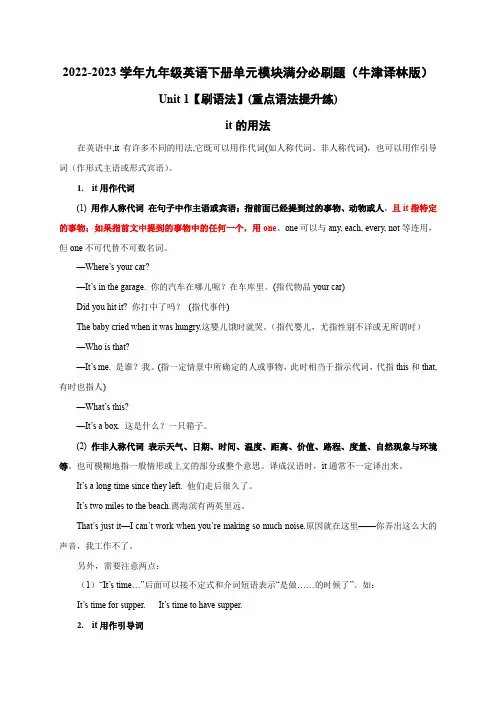
2022-2023学年九年级英语下册单元模块满分必刷题(牛津译林版)Unit 1【刷语法】(重点语法提升练)it的用法在英语中,it有许多不同的用法,它既可以用作代词(如人称代词、非人称代词),也可以用作引导词(作形式主语或形式宾语)。
1.it用作代词(1) 用作人称代词在句子中作主语或宾语;指前面已经提到过的事物、动物或人,且it指特定的事物;如果指前文中提到的事物中的任何一个,用one。
one可以与any, each, every, not等连用,但one不可代替不可数名词。
—Where’s your car?—It’s in the garage. 你的汽车在哪儿呢?在车库里。
(指代物品your car)Did you hit it? 你打中了吗?(指代事件)The baby cried when it was hungry.这婴儿饿时就哭。
(指代婴儿,尤指性别不详或无所谓时)—Who is that?—It’s me. 是谁?我。
(指一定情景中所确定的人或事物,此时相当于指示代词,代指this和that,有时也指人)—What’s this?—It’s a box. 这是什么?一只箱子。
(2) 作非人称代词表示天气、日期、时间、温度、距离、价值、路程、度量、自然现象与环境等。
也可模糊地指一般情形或上文的部分或整个意思。
译成汉语时,it通常不一定译出来。
It’s a long time since they left. 他们走后很久了。
It’s two miles to the beach.离海滨有两英里远。
That’s just it—I can’t work when you’re making so much noise.原因就在这里——你弄出这么大的声音,我工作不了。
另外,需要注意两点:(1)“It’s time…”后面可以接不定式和介词短语表示“是做……的时候了”。
如:It’s time for supper. It’s time to have supper.2.it用作引导词(1) 作形式主语由动词不定式、动词-ing短语或名词性从句担任主语的句子,常用it来作形式主语,而把真正的主语放在句子的后面。
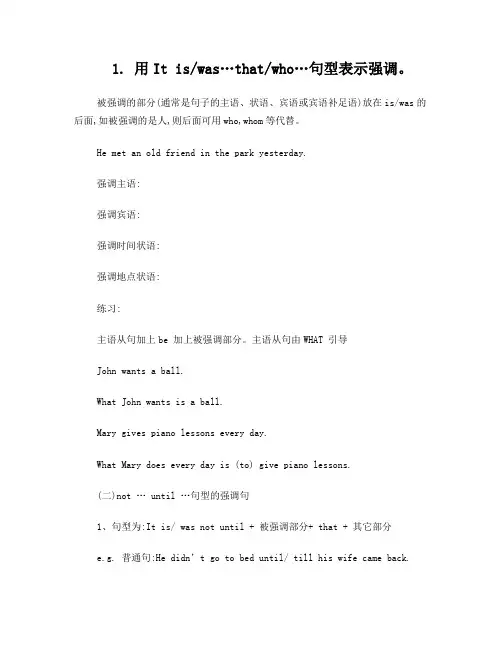
1. 用It is/was…that/who…句型表示强调。
被强调的部分(通常是句子的主语、状语、宾语或宾语补足语)放在is/was的后面,如被强调的是人,则后面可用who,whom等代替。
He met an old friend in the park yesterday.强调主语:强调宾语:强调时间状语:强调地点状语:练习:主语从句加上be 加上被强调部分。
主语从句由WHAT 引导John wants a ball.What John wants is a ball.Mary gives piano lessons every day.What Mary does every day is (to) give piano lessons.(二)not … until …句型的强调句1、句型为:It is/ was not until + 被强调部分+ that + 其它部分e.g. 普通句:He didn’t go to bed until/ till his wife came back.强调句:It was not until his wife came back that he went to bed.2、注意:此句型只用until,不用till。
但如果不是强调句型,till, until可通用;因为句型中It is/ was not …已经是否定句了,that后面的从句要用肯定句,切勿再用否定句了。
(三)谓语动词的强调1、It is/ was … that …结构不能强调谓语,如果需要强调谓语时,用助动词do/ does 或did。
e.g. Do sit down. 务必请坐。
He did write to you last week. 上周他确实给你写了信。
Do be careful when you cross the street. 过马路时,务必(千万)要小心啊!2、注意:此种强调只用do/ does和did ,没有别的形式;过去时用did ,后面的谓语动词用原形。
【高中英语】高中英语语法指导:it和one的区别简单点说one是“同类不同个”,it就是同一个!one与it都可替代上文出现的某个名词,但用法不同。
one用来指上文出现的某物中的一个,it指上文中的那个物。
下面我们去认真比较下:两者均可代替前面提到的事物,区别是:it指的是与前面已提到的事物为同一物,此时的it等于“the(this,that,my...)+名词”;而one指的是与前面已提到的事物为同一类物,此时的one等于“a+名词”。
比较:ihaveadictionarybuti’velentittomary.我存有一本词典,但把它借予玛丽了。
ihaven’tadictionary;canyoulendmeone?我没有词典,你能借我一本吗?考查it在习语中的用法包括it的习语很多,比如makeit就是其中很重要的一例。
如:youcanmakeitifyouhurry.如果你赶快还可以及时赶往。
hewantstomakeitasawriter.他想作一名作家而一举成名。
you needn’tworry;hewillmakeit.你不必害怕,他可以办好的。
one作代词的用法如下1.one替代由可数名词所则表示的一类人或事物中的任何一个,即为泛指中的特别强调.这时,替代词one前面不容提任何限定词.比如:1)ihopethereareenoughglassesforeachguesttohaveone.2)acolortvsetmadeinjapancostsmorethanonemadeinchina.3)-whocanlendmeachinese-englishdictionary?-ihaveone.2.one用来替代特指的同一类人或事物的可数名词时,其前面必须加上限定词(如a,the,this,that等)、物主代词或形容词加以修饰.例如:idon'twantthebookontheshelf,iwantthisoneonthedesk.。
高考英语语法知识之It 的用法总结1.It is + 被强调部分 + that ...该句型是强调句型。
将被强调的部分放在前面,其它部分置于that之后。
被强调部分可以是主语,宾语,状语。
强调的主语如果是人,that可以由who换用。
如果把这种句型结构划掉后,应该是一个完整无缺的句子。
这也是判断强调句型与其它从句的方法。
It was they that (who) cleaned the classroom yesterday. It was in the street that I met her father.2.It was not until + 被强调部分 + that ...该句型也是强调句型。
主要用于强凋时间状语,译成汉语"直到...才...",可以说是 not ... until ... 的强调形式。
It was not until she took off her dark glasses that I realized she was a famous film star.= Not until she took off her dark glasses did I realize she was a famous film star.= I didn’t realize she was a famous film star until she took off her dark glasses.3.It is clear ( obvious, true, possible,certain....) that .....该句型中it 是形式主语,真正的主语是that 引导的主语从句,常译为"清楚(显然,真的,肯定...)"是主语从句最常见的一种结构。
It is very clear that he’s round and tall like a tree.= That he’s round and tall like a tree is very clear.4. It is important ( necessary, right, strange, natural...) that ...由于主句中的形容词不同,that 后的从句中要用虚拟语气(should + 动词原形),should 可以省去。
高中英语真题:第四讲代词、It的用法一、代词考点透析1.人称代词的主格、宾格,两种物主代词及反身代词。
名词性物主代词themselves 人称代词的主格在句中作主语,宾格作宾语。
形容词性物主代词作定语,即其后必须有一个名词。
名词性物主代词在句中的作用相当于一个名词,可作主语、宾语、表语等,其后没有名词。
反身代词在主语、宾语、表语后作这些成分的同位语,意为“亲自”、“亲眼”、“某某本人”。
在语法填空中,这个知识点出现的频率相当高。
例如:(1)It was John himself that put him in trouble.(2)You can believe me.I saw it myself.2.one,ones,the one,that,those可以代替前面出现的名词,以避免重复。
one= a+名词单数,the one=the+名词单数,that=the+名词单数。
ones,those代替前面的名词复数,those =the+名词复数。
one,ones前可以有形容词修饰。
例如:(1)I don't like this skirt.I like the red one.(2)I'm planning to buy a house.I'd like one with a garden.(3)The population in Guangzhou is bigger than that in .(4)I prefer the apples in the basket to those in the box. 3.none,nothing,nobody(no one)的区别。
none既可指人,也可指物,且表特指概念,回答how many,how much等问题;nobody(no one)只能指人,且表泛指概念,常回答who引起的问题;nothing只能指物,常回答what引起的问题。
高中英语语法It的用法总结一、It 用作实词表达以下概念:指代前文提到的事物,如前文中的this, that;替代前文中的内容;指代一位性别不明的小孩或未知的人;指代未指明但谈话双方都知道的那件事;指代时间、天气、气候、距离等自然现象……二、It 用作形式主语替代作主语的从句、动词不定式、动名词,而把真正作主语的从句、动词不定式、动名词置于句尾。
It 作形式主语的常见句型:1. 代作主语的动词不定式,其句型为:(1) It be adj. (for sb.) to do sth.此处adj. 通常为描述事件的形容词:easy, difficult, hard, necessary, unnecessary, possible, impossible, likely, unlikely, right, wrong, important, unimportant, legal, illegal, well-mannered, ill-mannered, polite, impolite, clear, obvious, certain, suitable, proper, fit, useful, useless, dangerous…例: It is illegal (for a teenager) to drive a car without a license.(2) It be adj. of sb. to do sth.此处adj. 通常为描述人的形容词:kind, unkind, nice, rude, cruel, considerate, thoughtful, thoughtless, careful, careless, silly, foolish, stupid, clever, wise, crazy.例: It's kind of you to help me with the problem.(3) It替代作主语的动名词的常见句型:It's no good/use doing…It's (well)worth doing…It's (well)worth one's while doing/to do…It's (well)worth while doing/ to do例: It's no use crying over spilt milk(覆水难收).2. It替代作主语的从句常见句型:(1) It is + noun +从句例: It is no secret that the president wants to have a second term at office.(2) It is adj. +clauseIt's surprising that… (should)………竟然……It's a pity/shame that…(should)………竟然……例: It's important that you should apologize to her for your rudeness.(=It's of much importance that you should apologize to her for your rudeness.)(3) It verb sb. + clause= It is v-ing + clauseIt+surprise/delight/interest/disappoint/worry/disturb/annoy/amaze/bother/concern/frighten/please/anger sb. that…例: It worried me that she drove so fast.(= It was worrying that she drove so fast.)(4) It verb (to sb.) that…= sb/sth verb to do例: It (so) happened/chanced that they were out.(= They happened/chanced to be out.)(5) It is v-ed that…=sb/sth is to do(verb=say, report, think, believe, hope, expect, agree, accept, decide, determine, intend, plan, understand, know)例: It is said that the couple have gotten divorced.(=The couple are said to have gotten divorced.)(6) It is v-ed that … (should)…(verb=demand, request, require, order, suggest, advise, recommend例It is suggested that they should begin with the third question.三、It 作主语的句型1. It takes sb. … to do…(=sb takes…to do…)某人用多长时间做某事例: It took the men a week to mend our roof.(= The men took a week to mend our roof.)2. It's (just)(un)like sb. to do…(不)像某人做某事的风格例: It was (just) like him to think of helping us.3. It's (about/high) time that… should /v-ed…是该做某事的时候了例: It's(about/high) time that we should take action.4. It's the x-th time (that) … have v-ed…第几次做某事了例: It's the third time that he has failed the driving test.5. It is/has been… since …continuous v-ed(延续性动词) 某动作持续了多长时间例: It's 10 years since he lived here6. It was(not)… before…过(不)了多长时间某动作发生了例: It was not long before they arrived.四、It 作形式宾语用来替代作宾语的从句、动词不定式、动名词,而把真正作宾语的从句、动词不定式、动名词置于句尾。
高中英语语法权威解析目录:第01章名词性从句第02章“It”用法及其句型和固定搭配讲解第03章高中英语语法中的省略现象第04章主谓一致第05章动词不定式第06章倒装结构第07章定语从句第08章被动语态第09章祈使句第10章感叹句第11章疑问句第12章名词第一章名词性从句在句子中起名词作用的句子叫名词性从句(Noun Clauses)。
名词性从句的功能相当于名词词组, 它在复合句中能担任主语、宾语、表语、同位语、介词宾语等,因此根据它在句中不同的语法功能,名词从句又可分别称为主语从句、宾语从句、表语从句和同位语从句。
一.主语从句主语从句是在复合句中充当主语的从句,通常放在主句谓语动词之前或由形式主语it代替,而本身放在句子末尾。
1. It 作形式主语和it引导强调句的比较It 作形式主语代替主语从句,主要是为了平衡句子结构,主语从句的连接词没有变化。
而it引导的强调句则是对句子某一部分进行强调,无论强调的是什么成分,都可用连词that。
被强调部分指人时也可用who/whom。
例如:a) It is a pity that you didn‟t go to see the film. 你不去看那场电影真可惜。
b) It doesn‟t interest me whether you succeed or not.我对你成功与否不感兴趣。
c) It is in the morning that the murder took place.谋杀案是在早上发生的。
(强调句型)d) It is John that broke the window.是John打碎的窗户。
(强调句型)2. 用it 作形式主语的结构(1) It is +名词+从句It is a fact that … 事实是…It is an honor that …非常荣幸It is common knowledge that …是常识(2) It is +形容词+从句It is natural that… 很自然…It is strange that… 奇怪的是…(3) It is +不及物动词+从句It seems that… 似乎…It happened that… 碰巧…It appears that… 似乎…(4) It +过去分词+从句It is reported that… 据报道…It has been proved that… 已证实…It is said that… 据说…3. 主语从句不可位于句首的五种情况:(1)if 引导的主语从句不可居于复合句句首。
高中英语语法知识点对知识的渴求是人类的自然意向,任何头脑健全的人都会为获取知识而不惜一切。
下面小编给大家分享一些高中英语语法知识,希望能够帮助大家,欢迎阅读!高中英语语法知识1定语从句一、关系代词引导的定语从句1、that 指人或物在从句中作主语,宾语或表语which 指物在从句中作主语,宾语或表语(作宾语时可以省略)who 指人在从句中作主语,宾语或表语whom 指人在从句中作宾语whose 指人或物在从句中作定语as 指人或物在从句中作主语,宾语或表语but 指人或物在从句中作主语,宾语或表语注意:指物时,whose+名词=the+名词+of which或of which+the+名词2、as 的用法(1)常用于下列结构:such…as; so…as;the same…as; as…as注意:the same…as 表示同一类,不同一个the same…that 表示同一个(2)as与which的区别a、位置不同as可放在主句后,主句前或主句中间;which只能放在主句后。
b、as起连接作用,表达说话人的观点、看法,并指出主句内容的根据或出处,意为“正如,正像”。
Which相当于并列句,可以用and this来代替,意为“这一点,这件事’”。
注意:as常用于下列结构:as we know/ as is known to all, as we all can see, as has been said before/above,as might be excepted, as is often the case, 一般不能用which代替as。
c、在从句中作主语时,which既可作系动词be的主语也可作实义动词的主语,而as只可作系动词be的主语。
二、只用that不用which的情况1、.先行词为all , much, everything, nothing , something ,anything, nothing, none, the one等不定代词时2、先行词被only, any, few, little, no , all, just , very ,right等修饰时.3、当先行词是最高级或被形容词最高级修饰时。
高中英语语法:It的用法it可用作人称代词、指示代词、先行词及引导词等。
1. 人称代词it,是第三人称单数中性,代表前文已提到过的一件事物。
如:1)That vase is valuable. It's more than 200 years old. 那个花瓶很珍贵,它有200多年的历史。
2)I love swimming. It keeps me fit. 我喜欢游泳,它能使我保持健康。
当说话者不清楚或无必要知道说话对象的性别时,也可用it来表示。
如:3)It's a lovely baby. Is it a boy or a girl? 宝宝真可爱,是男孩还是女孩?it可用来指代团体。
如:4)The committee has met and it has rejected the proposal. 委员会已开过会,拒绝了这项建议。
it用以代替指示代词this, that.如:5)--- What's this? --- It's a pen. —这是什么?—是一支钢笔。
6)--- Whose book is that? --- It's Mike's. —那是谁的书?—是迈克的。
2. 指示代词it,常用以指人。
如:7)Go and see who it is. 去看看是谁。
8)--- Who is making such a noise? —是谁发出这样的吵闹声?--- It must be the children. —一定是孩子们。
3.虚义it无指代性,常用作没有具体意义的主语,出现于表示天气、气候、温度、时间、地点、距离等意义的句子中。
如:9)It is half past three now. 现在是三点半钟。
10)It is six miles to the nearest hospital from here. 这里离最近的医院也有六英里。
11)It was very cold; it snowed and grew dark.天气很冷;天下着雪,渐渐地变黑了。
it也常用来表示一般的笼统的情况。
如:12)It's awful—I've got so much work I don't know where to start. 糟透了——我有这么多工作要做我不知从何开始。
13)How is it going with you? 你近况如何?14)Take it easy. 不要紧张。
it也常用于下列结构:15)It looks as if the college is very small. 看起来这个学院很小。
16)It seems as though our plan will be perfect. 似乎我们的计划很完善。
17)It's my turn. 该轮到我了。
it也常用于某些习惯用语中作宾语,各该习惯用语有具体意义,但it并无具体意义。
如:cab it 乘车catch it 受责,受罚come it 尽自己分内come it strong 做得过分walk it 步行make it 办成take it out of somebody 拿某人出气4. 先行词it.it充当形式主语或形式宾语,本身无意义,只起一种先行引导的作用,先行词不重读。
后面的真正主语或真正宾语通常是不定式结构、-ing分词结构或名词性从句。
(1)用作形式主语18)It is difficult to translate this article. 翻译这篇文章很难。
19)It is getting harder every day for a lazy man to get a living. 懒汉谋生是日益困难了。
20)What time would it be most convenient for me to call again?什么时候我再给你打电话最合适?21)It is no use going there so early. 这么早去那里没有用。
22)It has been a great honour your coming to visit me. 你的来访是我很大的荣幸。
23)It is strange that he did not come at all. 真奇怪,他竟还没来。
24)It doesn't matter what you do.什么都没关系。
在上述诸例中,后置的真正主语可以取代先行it的位置,而出现于句首。
To translate this article is difficult.Going there so early is no use.That he did not come at all is strange.上述结构远不如用先行it结构普通。
此外,也并非所有先行it结构都可作上述转换。
如:25)It seems that John is not coming after all. 似乎约翰终竟不来。
26)It happened that John was the only witness. 碰巧约翰是唯一的证人。
上述两例只能转换为:John doesn't seem to be coming after all.John happened to be the only witness.(2)用作形式宾语27)I found it difficult to explain to him what happened. 我觉得向他解释清发生了什么事很困难。
28)He thought it no use going over the subject again. 他认为再讨论这个问题没有用了。
29)They kept it quiet that he was dead. 他们对他的死保密。
30)We must make it clear to the public that something should be done to stop pollution.我们必须使公众明白应该采取措施制止污染。
5. 分裂句引导词it.分裂句是以it为引导词的强调句型。
它的结构形式是:It+be的一定形式+中心成分+that-/who-从句。
如:31)It was Jane that/who called this morning. 是珍妮今天上午打来电话。
32)It was a parcel that she brought him. 她带给他的是一个包裹。
分裂句是由普通陈述句转换而来的。
通过这种结构可以强调除谓语动词以外的大多数句子成分。
如:33)John gave Mary a handbag at Christmas. 约翰在圣诞节给了玛丽一个提包。
根据上下文和语义意图,说话人可以通过分裂句分别强调主语、间接宾语、直接宾语、状语,使之成为信息中心。
34)It was John that/who gave Mary a handbag at Christmas. 是约翰在圣诞节给了玛丽一个提包。
35)It was Mary that John gave a handbag (to)at Christmas. 约翰在圣诞节是给玛丽提包的。
36)It was a handbag that John gave Mary at Christmas. 约翰在圣诞节给玛丽的是一个提包。
37)It was at Christmas that John gave Mary a handbag. 是在圣诞节约翰给了玛丽一个提包。
分裂句的时态一般应一致,即主句与从句的时态应皆用现在时,或皆用过去时,或皆用将来时。
如:38)It is not I who am angry. 发怒的不是我。
39)It was my two sisters who knew her best. 是我的两个姐妹最了解她。
40)It will not be you who will have to take the blame for this. 对此须受责难的将不是你。
有时分裂句的谓语动词还可以采取复杂形式。
如:41)It may have been at Christmas that John gave Mary a handbag. 可能是在圣诞节约翰给玛丽一个提包。
42)It might have been John who gave Mary a handbag. 很可能是约翰给了玛丽一个提包。
分裂句可以强调多种多样的状语成分。
如:43)It was when she was about to go to bed that the telephone rang. 是在她即将上床睡觉时电话铃响了。
44)It was because I wanted to buy a dictionary that I went to town yesterday. 我昨天是由于想买一本词典而进城的。
45)It was not until his father came back that Tom went to bed yesterday.昨天汤姆是直到他父亲回来才上床睡觉的。
(注意句中not的位置)主语补语通常不可以用作分裂句的中心成分,如在规范英语中通常不说:It is beautiful that she is.It is chairman of the Committee that he is.但是宾语补语是可以这样用的。
如:46)It is the chairman of the committee that they elected him. 他们选他是作委员会主席。
47)It is green that they have painted the wall. 他们把墙壁漆的是绿色。
注:(1)当强调的中心成分为主语,指人时可用连词that或who,如上述例(31)、(34)、(38),强调其余的成分时,连词一律用that。
(2)分裂句中的that与who在非正式文体中可以省略,如:48)It was the President himself spoke to me.是总统亲自和我谈了话。
(省去从句主语who)49)It was the dog I gave the water to. 我是给那条狗水的。
(省去从句的宾语that)50)It was yesterday I first noticed it. 我是昨天开始注意到的。
(省去从句连词that)有时还可省去句首的it is,如:51)A good, honest trade you are learning, Sir Peter! 彼得爵士,你学得是一种很好而诚实的一行啊!(3)分裂句中的被强调部分有时可放在句首,如:52)Now was it that his life was done, and the fate which he could not escape was upon him.就在这时,他的生命完结了,他所逃不脱的命运降临了。